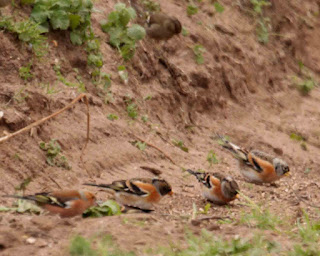For a few years back in the early / mid 2000's I would lead Spring wildlife watching holidays to the Spanish Pyrenees. Following one of these trips I sketched out the following thoughts on why clients on these trips were so keen on seeing a Wallcreeper.
 |
| Winter Wallcreeper at Riglos |
"Why is Wallcreeper the most sought after bird on every trip I have led to the Spanish Pyrenees, the bird that seems to sum up these wild mountains. The species that on the first day of the holiday we take the group in search of under the towering rock face of Gabardito, so that we have time to try again here later in the week should we fail?
Wallcreeper the bird that each year without fail members of the party will sidle up to me in the departure hall at Stansted, and ask in a whisper “Its not that I’m a twitcher or anything, but I’d really like to see a Wallcreeper. What chance have we got?”
I feel that part of this birds appeal must lie in its association with high, wild, inaccessible places like the Pyrenees. To have seen one means that you have joined a small select club of birdwatchers.
The walk to Gabardito starts in a small car park next to a Refugio, on the edge of an alpine meadow ringed by mountain peaks that are over flown by Griffon Vultures and the occasional Lammergeir. From here it is an uphill walk along a narrow side valley, gaining height as we pass through beech woods and pine clad rocky slopes. The surface of the path is a little uneven in places and has a steep drop on one side. Choughs fly overhead their metallic calls echoing around us. Different members of the group handle this ascent in their own way. For some it is an easy uphill walk, others describe it as ‘hard’ as much for the overwhelming and unfamiliar mountain scenery as the physical exertion involved.
Even when you are in the right place you have no certainty of success and again even when the bird has been spotted you, the individual being guided to this time and place, have to work hard to follow the directions across the almost featureless rock-face to spot a small, well camouflaged and distant bird. To have done this gives you ownership of the sighting a sense of satisfaction of having worked for your bird.
So after all the exertion of the climb, the giddying drops to the side of the path, the wait whilst you and the guide scan the vast rock face for this small well camouflaged bird, followed by the anxious moments whilst you try and find the birds in your binoculars. Now your onto the bird and can enjoy the moment, watching a small purple, black and grey bird with scimitar beak and butterfly wings, the shared excitement with your fellow travellers and of course the anticipation of being able to tell friends back home of your successful journey into the Wallcreepers mountain home.
Yet after all this I am often surprised that when it comes to the end of a week full of wonderful wildlife and landscape experiences in this amazing corner of Wild Spain and I ask the group for their bird of trip or Champagne moment, Wallcreeper will often not feature on either list despite having been seen by everyone. Is this because this unique bird’s legend out does the reality of its appearance or is it because in the guests hearts they expect to see one and it is the unexpected surprises that really etch themselves onto folks memories?"







